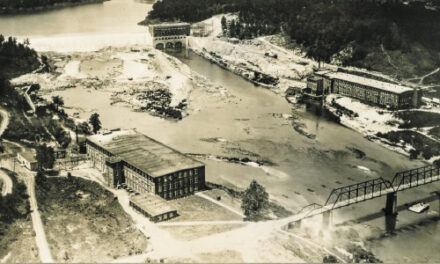
How does a town become owned, lock, stock and barrel by the power company? Sherrie Hartsoe Sigmon knows because her extensive research on Rhodhiss provides an example. By the way, get ready for a big celebration of the town coming up next week. More about that soon. – RE
Rhodhiss Manufacturing and E. A. Smith Manufacturing operated in Rhodhiss from 1902 and 1914 respectively to 1919. George Hiss had controlling interest in both. In 1919 Duke Power, previously known as Southern Power, wanted the water rights, so they purchased the land, the mills, the houses, the company store, the office building, and the school; thus, Duke bought Rhodhiss. Not interested in textiles, Duke leased the mills to various stockholders: R. C. Moore, Walter Moore, Harvey Moore, and Clarkson Jones.
In 1920 Women’s Wear stated the sale price of $2,400,000 for the Caldwell plant and $1,800,000 for the Burke mill. The Lenoir News Topic reported, “Southern Power Company engineers are seeking for rock bottom on the Catawba river above the present dam at Rhodhiss. By building several hundred feet above the present site, the company will not be compelled to dismantle the two cotton mills.” Hydroelectricity was completed in 1925, and the mill houses obtained power in 1926. Massie Mullinax wired the mills and the houses, and he was described as “a man before his time and a master mechanic.” Several people commented that Rhodhiss was the first fully electrified town for its size in the state. Electricity was included in the rent, so meters didn’t come until 1955 with the sale of the houses. Hans Townsend stated, “The houses were wired, but they turned the power off in the daytime. Every Thursday afternoon they turned it on so you could iron.” Shelley Teague, Butler Monteith, and Willard Herman stated, “The dam’s builder, Reinhardt and Dennis, built shacks for the black workers over at Rhodhiss Beach.” Shelley called them “tar paper shacks,” and Butler said “shanties.” Sightseers came to view the dam’s construction. Butler said, “Oh, man I am telling you. On Sundays that road was so full that you couldn’t get up and down it on the weekends. They brought an old steam shovel. Everybody around the country came to see that thing operate.”

Ned Bean and Earl Lingle discussed the dam’s rock that came from the nearby quarry. Pawnee Mullinax Simmons elaborated, “We would be in the yard, and we’d hear the blasts. I don’t think that any rocks ever came down to us. They dynamited a lot of places. I would fly in the house.” Stories have circulated for years that a man fell in the dam and was buried by cement. When questioned, Teague said, “Oh, that’s just a dam lie.”
Upon the dam’s completion, Duke Power, accommodated the powerhouse workers by having its own village with 10 to 12 houses, which were later torn down or moved. Reinhardt and Dennis left equipment because it was not cost effective to move it. Billie Sue Laney explained that this machinery was donated to the metal collection effort for World War II. Duke sold the town to Pacific Mills in 1945, so the mill company owned the power lines, but in 1955 Duke purchased them from Pacific.
Presently Rhodhiss supplies electricity to nearby communities. Rhodhiss’ vital role within the area continues.
Photo: Building the Rhodhiss Duke Power Dam.









